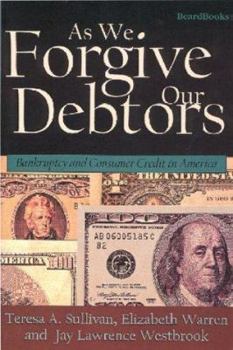As We Forgive Our Debtors: Bankruptcy and Consumer Credit in America
Select Format
Select Condition 
Book Overview
Bankruptcy in America is a booming business. Hundreds of thousands of ordinary Americans each year have joined giant corporations, like Johns Manville and Continental Airlines, and once-wealthy... This description may be from another edition of this product.
Format:Paperback
Language:English
ISBN:1893122158
ISBN13:9781893122154
Release Date:January 1999
Publisher:Beard Books
Length:388 Pages
Weight:1.30 lbs.
Dimensions:1.0" x 6.0" x 9.2"
Customer Reviews
3 ratings
An Excellent Study
Published by Thriftbooks.com User , 17 years ago
The authors add a lot of substance to the basic tautology that people who are broke declare bankruptcy. Not only do they both acknowledge and recognize this basic tautology, for the first time, in quantitative terms, they define just what it means to be broke. For the authors, merely coming up short at the end of the month does not qualify one as being broke (though most of us wage earning schmucks would tend to disagree). They demonstrate exactly what level of indebtedness generally forces people to seek the protection of the bankruptcy courts. Based on their work, the key metric appears to be the debt to income ratio, and their analysis shows that the bankrupt tend to have debts that exceed their gross annual income, or in quantitative terms, a debt to income ratio greater than one. Finally, they establish a tipping point based on the debt to income ratio that specifies the point in time at which the indebted fall into the abyss of bankruptcy, which appears to be when debts are eight-tenths of a household's most recent full employment annual gross income. Honestly speaking, although the material presented is dense, and the text is top-heavy with citations, footnotes and whatnot, the book still reads well. The authors manage to provide a comprehensive treatment of the topic without sacrificing readability. The reader learns about the history and function of US bankruptcy, the various debtors in bankruptcy and also gleans a fair bit of knowledge about creditors in bankruptcy. One slight improvement to the text would have been a summary chapter for the time pressed which could have highlighted the major findings of the study. Otherwise, the authors succeeded admirably in contributing something of value to the bankruptcy literature and to general scholarship. The book does have several severe limitations, most likely put in place by a colluding cabal of federal agencies and private banking/financial institutions (one could speculate with giddy glee as to why these parties would not want a clear picture of bankruptcy to emerge). I noticed that the sample size, which stood at about 2400, was barely adequate for good statistical inference. The authors pulled the sample from records obtained in three states. A more appropriate (and comprehensive) study would have obtained samples of about this size from each and every state of the union. A statistically literate observer would note that any inferences about the larger population based on such a small sample size would be highly suspect, given that obvious socioeconomic and demographic differences exist within each state, and also that bankruptcy laws tend to vary from state to state. Still, at no point did the authors reason beyond the limits of the available data, nor did they engage in any speculation. In the authors' defense, I must concede that subsequent studies into the US bankruptcy conundrum have affirmed all of their conclusions and most disturbingly, their predictions. The o
SELF-FULLFILLING PROPHECY OF DEBT
Published by Thriftbooks.com User , 20 years ago
This book does an outstanding job of delivering the message that Americans are tapped out of money. From record setting personal bankruptcies to U.S. government's pension for borrowing, it is very easy to see that we as a populis and as a nation are on the edge of a new financial depression. An Excellent Read for Anyone interested in the Truth. - Mason Johnson, President, www.tomorrowsgold.com
Landmark Study of Consumer Bankruptcy in the U.S.
Published by Thriftbooks.com User , 23 years ago
As We Forgive Our Debtors is a result of a landmark study of bankrupt debtors in the 1980s. The authors, three of the leading experts on bankruptcy in the United States, focus on who files for bankruptcy. Contrary to widespread myth, most bankrupts are not irresponsible spendthrifts who could afford to pay their debts. Instead, they cross all income and occupational levels. What they do have in common is they have insurmountable financial problems resulting from crises in their lives, including divorce, job loss, and medical problems. What is perhaps most disturbing is that single women have been and are increasingly filing for bankruptcy, thanks to their much lower salaries to begin with. It is this group who would suffer most from any kind of so-called bankruptcy reform.This book, while it is geared for an academic market, is actually highly readable, with copious footnotes at the end of each chapter. The book, while originally published in 1989, is more timely than ever as Congress is considering a fatally flawed bankruptcy reform bill which would be devasting to the vast majority of people filing for bankruptcy but a boon to the credit card industry.I highly recommend this book and its sequel, The Fragile Middle Class.




